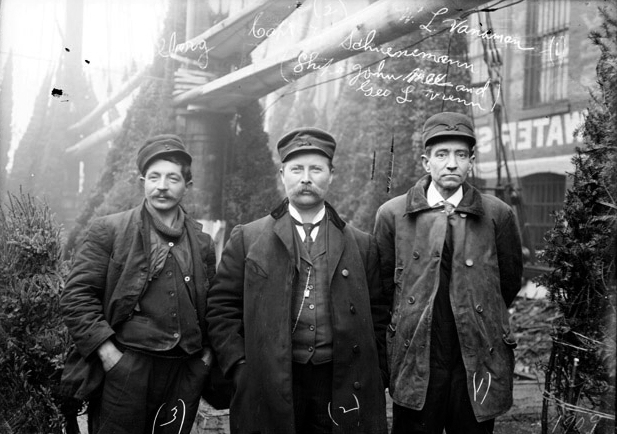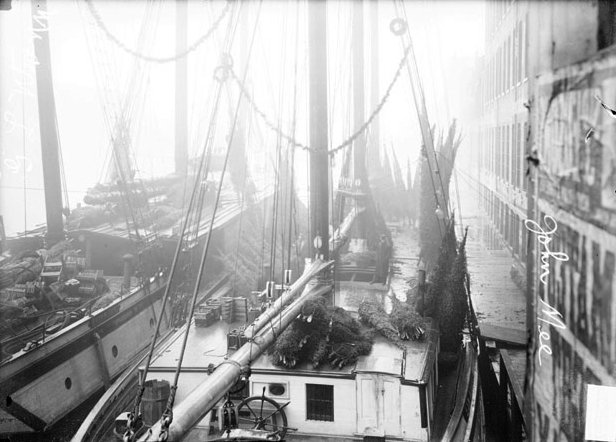The Mysterious Ghost Ship of Lake Michigan
Originally published in The Rock River Times
The Holiday Season between Thanksgiving and New Year’s Day is often referred to as “The Most Wonderful Time of Year”. But others point out that there is something beyond the colorful lights and tinsel that can make this time of the year seem eerie and dark. The shorter days and much longer nights leave a lot more time for the bumps in the night to make us wonder if something else is lurking just beyond the flickering lights. In fact, many cultures share ghost stories during their Winter Celebrations.
During this time of year, friends and families gather to celebrate the season with certain traditions. One of the most enduring traditions involves hauling an evergreen tree into the house and decorating it with lights, ornaments, and garland. While it is very easy these days to find these trees, it wasn’t always the case, especially in the bigger cities like Milwaukee or Chicago.
Most folks purchased their tree from wholesalers or local store. These vendors were supplied the trees by local shipping businesses. These men loaded their ships with freshly cut trees from the upper parts of Michigan and Wisconsin and then sailed down the coast of Lake Michigan to deliver them to the vendors. It was a dangerous business with the severity of the storms that would blow in without warning to the lake. These ships were called “Christmas Tree Ships” and during the years between late 1870’s and 1920’s, they brought thousands of the trees to this area.
One family that became famous for delivering these trees were the Shuenemanns. There were three brothers in the family and they began to transport trees in 1876. They ran this business even after one brother, August was killed during the November run in 1898. Herman Schuenemann had to put his grief aside that season and he brought two loads of trees down that year. By this time, Herman had three children of his own to support and took on the responsibility of August’s wife and children.
The Shuenemann families lived in Chicago close to the Clark Street docks and knew that many folks couldn’t afford a tree. They decided that they would sell the trees directly to the folks in the area. In order to keep their overhead low, they sold these trees right off the boat. They decorated it with Christmas lights and guaranteed the lowest prices. A lot of the people that lived in the area stated that the Christmas Season started when the Schuenemann ship sailed up to the dock. Herman was always known to give a few trees away to the families that couldn’t afford to pay for one. Herman earned such a good reputation for his generosity, that he was given the nickname “Captain Christmas”.
In 1910, Herman bought a share of the 124 foot long schooner named the Rouse Simmons. The schooner was built in 1868 and had been used for hauling lumber for its whole life. Herman was proud to be the captain of this ship that had created a good reputation for over 25 years of sailing the Great Lakes. By 1912, the Rouse Simmons was beginning to show her age and many speculated that she might not be sea worthy any longer. That year the storms had been particularly brutal and roared in earlier than other years. Some of the Christmas Tree ships had decided that it was too risky to make the run that year.
This made Herman even more determined to make the run. The wagons carrying the trees from the local farms came to the dock and were unloaded. They stacked the evergreens into every available space until over 5,000 trees were jammed onboard. The Rouse Simmons sat low in the water and Herman cast a worried eye to the ominous clouds that were moving in. Though some of the crew thought they should wait out the storm, Herman knew that this would be the last sail of the season. He decided to head out and hoped that he could outrun the storm.
Unfortunately, the storm slammed into the ship shortly after it left the safety of the port. The 60 mile an hour winds drove the icy rain down on the deck of the Rouse Simmons. Soon the trees stacked on board were covered with snow and ice. The weight of the trees pushed the already overloaded Rouse Simmons deeper into the water.
The ship was seen by the Life Saving Station at Sturgeon Bay. They reported that the ship was flying its distress flags and was struggling with the large waves that were now breaking over her bow. All of the Life Saving Stations were on high alert because of the gale. The Two Rivers Station had a power boat that was sent to spot the Rouse Simmons. The ship was spotted only once for a brief moment. Later reported to look more like a block of ice than a ship, those that witnessed her felt there was little chance for the ship to survive the storm. It was the last time the Rouse Simmons would be spotted for over 60 years.
By December 13th, all hope was gone when frozen Christmas trees began to wash up on the shores of the Lake. A tree decorated with black ribbon was placed along the bridge at Clark Street where the Rouse Simmons would normally dock.
Later, a bottle was washed up by Sheboygan, Wisconsin. The message inside read, “Friday..everybody goodbye. I guess we are all through. During the night the small boat was washed overboard. Leaking bad. Invald and Steve lost too. God help us. Herman Schuenemann.”
Herman’s wife Barbara and her two daughters would continue his legacy by shipping the trees on trains and then selling them off a rented ship. They continued to sell trees on the Clark Street Bridge until Barbara’s death in 1933. The daughters later opened a store on North Lasalle Street to sell trees and other Christmas decorations.
The Great Lakes held onto the secret of what had happened to the Rouse Simmons until October 30, 1971 when scuba diver Kent Bellrichard from Milwaukee stumbled unto the wreck by accident. The ship lay in 165 feet of water about twelve miles northeast of Two Rivers. After close examination it was discovered that the wheel had been damaged when the mizzenmast driver boom, which was the support for the main sail, snapped and crashed in to the wheel, damaging it. The Rouse Simmons was completely at the mercy of the storm and unable to steer to safety. The Christmas trees still lined it decks. One of the trees was later stood on the front as a memorial to the men who died onboard.
Shortly after the disappearance of the Christmas Tree Ship, rumors began to spread amongst the sailors on Lake Michigan. Many of them told stories of spotting the doomed schooner, still covered in ice, laboring low in the water as she made her way toward home.
Other stories came not from sailors but from folks who lived on the shore of Lake Michigan. One woman, Joyce Phippen was interviewed by Rochelle Pennington for her book, The Historic Christmas Tree Ship. Phippen swore she had witnessed the ship twice: once at dusk and another time during the night. She described the ship as seeming to float above the water, still heavily covered in ice and emerging from a heavy mist.
None of the crew of the Rouse Simmons was ever recovered. Herman’s wallet was brought up in a fisherman’s net from the bottom of the lake in 1923. It was wrapped in oilskin which protected it contents. Inside were business cards, an expense sheet, and an article about the Christmas tree ship and Captain Santa.
The Schuenemann family’s legacy of supplying Christmas trees to everyone whether they could afford to pay or not continues even to this day. The US Coast Guard Cutter Mackinaw brings a load of trees from northern Michigan to hand out to families who otherwise would not have a tree for their celebrations.
The storm of 1912 was reported as one of the worst up to that time on the Great Lakes. Many lives were lost during that storm. But the story of the Rouse Simmons is still shared today. Some say it is due to the sacrifice of Herman and the other men who died trying to bring joy to folks for the holiday. Others say it is due to the women in Herman’s family who carried on his legacy. Still others say that it is due to the sightings of the ice ladened ship that continue even today.
Photographs are from Schoolcraft County Historical Society.
Copyright © 2022 Kathi Kresol, Haunted Rockford Events



